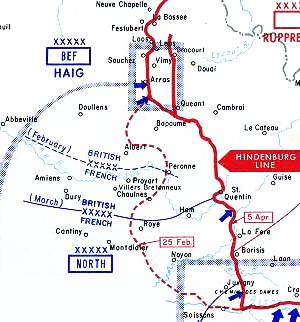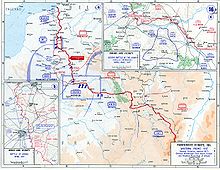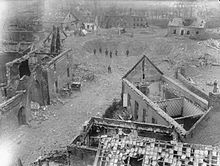
The Third Battle of Ypres, also known as the Battle of Passchendaele, was a campaign of the First World War, fought by the Allies against the German Empire. The battle took place on the Western Front, from July to November 1917, for control of the ridges south and east of the Belgian city of Ypres in West Flanders, as part of a strategy decided by the Allies at conferences in November 1916 and May 1917. Passchendaele lies on the last ridge east of Ypres, 5 mi (8 km) from Roulers, a junction of the Bruges-(Brugge)-to-Kortrijk railway. The station at Roulers was on the main supply route of the German 4th Army. Once Passchendaele Ridge had been captured, the Allied advance was to continue to a line from Thourout to Couckelaere (Koekelare).

The Battle of the Somme, also known as the Somme offensive, was a major battle of the First World War fought by the armies of the British Empire and the French Third Republic against the German Empire. It took place between 1 July and 18 November 1916 on both sides of the upper reaches of the river Somme in France. The battle was intended to hasten a victory for the Allies. More than three million men fought in the battle, of whom more than one million were either wounded or killed, making it one of the deadliest battles in all of human history.

The Hindenburg Line was a German defensive position built during the winter of 1916–1917 on the Western Front in France during the First World War. The line ran from Arras to Laffaux, near Soissons on the Aisne. In 1916, the Battle of Verdun and the Battle of the Somme left the German western armies exhausted and on the Eastern Front, the Brusilov Offensive had inflicted huge losses on the Austro-Hungarian armies and forced the Germans to take over more of the front. The declaration of war by Romania had placed additional strain on the German army and war economy.

The Battle of Arras was a British offensive on the Western Front during the First World War. From 9 April to 16 May 1917, British troops attacked German defences near the French city of Arras on the Western Front. The British achieved the longest advance since trench warfare had begun, surpassing the record set by the French Sixth Army on 1 July 1916. The British advance slowed in the next few days and the German defence recovered. The battle became a costly stalemate for both sides and by the end of the battle, the British Third Army and the First Army had suffered about 160,000 casualties and the German 6th Army about 125,000.

The Battle of Le Transloy was the last big attack by the Fourth Army of the British Expeditionary Force (BEF) in the 1916 Battle of the Somme in France, during the First World War. The battle was fought in conjunction with attacks by the French Tenth and Sixth armies on the southern flank and the Reserve/5th Army on the northern flank, against Army Group Rupprecht of Bavaria created on 28 August. General Ferdinand Foch, commander of groupe des armées du nord and co-ordinator of the armies on the Somme, was unable to continue the sequential attacks of September because persistent rain, mist and fog grounded aircraft, turned the battlefield into a swamp and greatly increased the difficulty of transporting supplies to the front over the roads land devastated since 1 July.

The Battle of the Ancre Heights, is the name given to the continuation of British attacks after the Battle of Thiepval Ridge from 26 to 28 September during the Battle of the Somme. The battle was conducted by the Reserve Army from Courcelette near the Albert–Bapaume road, west to Thiepval on Bazentin Ridge. British possession of the heights would deprive the German 1st Army of observation towards Albert to the south-west and give the British observation north over the Ancre valley to the German positions around Beaumont-Hamel, Serre and Beaucourt. The Reserve Army conducted large attacks on 1, 8, 21, 25 October and from 10 to 11 November.

The Hundred Days Offensive was a series of massive Allied offensives that ended the First World War. Beginning with the Battle of Amiens on the Western Front, the Allies pushed the Imperial German Army back, undoing its gains from the German spring offensive.

The Attacks on the Butte de Warlencourt describe a tactical incident during the Battle of the Somme. The Butte de Warlencourt is an ancient burial mound off the Albert–Bapaume road, north-east of Le Sars in the Somme département in northern France. It is located on the territory of the commune of Warlencourt-Eaucourt and slightly north of a minor road to Gueudecourt and Eaucourt l'Abbaye. During the First World War, German troops constructed deep dugouts in the Butte and surrounded it by several belts of barbed wire, making it a formidable defensive position in advance of Gallwitz Riegel. After the Battle of Flers–Courcelette, the view from the Butte dominated the new British front line and was used by the Germans for artillery observation.

The Second Battle of the Somme of 1918 was fought during the First World War on the Western Front from late August to early September, in the basin of the River Somme. It was part of a series of successful counter-offensives in response to the German Spring Offensive, after a pause for redeployment and supply.

The Second Battle of the Aisne was the main part of the Nivelle Offensive, a Franco-British attempt to inflict a decisive defeat on the German armies in France. The Entente strategy was to conduct offensives from north to south, beginning with an attack by the British Expeditionary Force (BEF) then the main attack by two French army groups on the Aisne. General Robert Nivelle planned the offensive in December 1916, after he replaced Joseph Joffre as Commander-in-Chief of the French Army.
Battle of Albert was the third battle by that name fought during World War I, following the First Battle of Albert and the Second Battle of Albert, with each of the series of three being fought roughly two years apart. This smaller third battle was significant in that it was the opening push that would lead to the Second Battle of the Somme and involved the Australian Corps. This attack opened the advance; the main thrust was launched by the Third Army along with support from the Fourth Army. The Second Battle of Bapaume, from 25 August to 3 September, was a continuation of this battle.

Operation Michael was a major German military offensive during the First World War that began the German Spring Offensive on 21 March 1918. It was launched from the Hindenburg Line, in the vicinity of Saint-Quentin, France. Its goal was to break through the Allied (Entente) lines and advance in a north-westerly direction to seize the Channel Ports, which supplied the British Expeditionary Force (BEF), and to drive the BEF into the sea. Two days later General Erich Ludendorff, the chief of the German General Staff, adjusted his plan and pushed for an offensive due west, along the whole of the British front north of the River Somme. This was designed to first separate the French and British Armies before continuing with the original concept of pushing the BEF into the sea. The offensive ended at Villers-Bretonneux, to the east of the Allied communications centre at Amiens, where the Allies managed to halt the German advance; the German Army had suffered many casualties and was unable to maintain supplies to the advancing troops.

In 1917, during the First World War, the armies on the Western Front continued to change their fighting methods, due to the consequences of increased firepower, more automatic weapons, decentralisation of authority and the integration of specialised branches, equipment and techniques into the traditional structures of infantry, artillery and cavalry. Tanks, railways, aircraft, lorries, chemicals, concrete and steel, photography, wireless and advances in medical science increased in importance in all of the armies, as did the influence of the material constraints of geography, climate, demography and economics. The armies encountered growing manpower shortages, caused by the need to replace the losses of 1916 and by the competing demands for labour by civilian industry and agriculture. Dwindling manpower was particularly marked in the French and German armies, which made considerable changes in their methods during the year, simultaneously to pursue military-strategic objectives and to limit casualties.

Operations on the Ancre took place from 11 January – 13 March 1917, between the British Fifth Army and the German 1st Army, on the Somme front during the First World War. After the Battle of the Ancre, British attacks on the Somme front stopped for the winter. Until early January 1917, both sides were reduced to surviving the rain, snow, fog, mud fields, waterlogged trenches and shell-holes. British preparations for the Battle of Arras, due in the spring of 1917, continued.

The Capture of Martinpuich took place on 15 September 1916. Martinpuich is situated 18 mi (29 km) south of Arras, near the junction of the D 929 and D 6 roads, opposite Courcelette, in the Pas-de-Calais, France. The village lies south of Le Sars, west of Flers and north-west of High Wood. In September 1914, during the Race to the Sea, the divisions of the German XIV Corps advanced on the north bank of the Somme westwards towards Albert and Amiens, passing through Martinpuich.

The Capture of Gueudecourt is a tactical incident of the First World War during the Battle of the Somme. The village lies on the Le Sars–Le Transloy road, north-east of Flers and north-west of Lesbœufs. Behind Gueudecourt lay open country which had hardly been shelled with Le Barque in the middle distance and then Bapaume beyond. German troops had passed through the village in late September 1914 during the First Battle of Albert, part of reciprocal attempts by the German and Franco-British armies to advance round the northern flank of their opponent during the operations known as the Race to the Sea. The village became a backwater until 1916 when the Germans built a third defensive position behind the Somme front, in preparation for the British–French offensive being prepared on the Somme.

The Capture of Lesbœufs [25 September 1916] was a tactical incident in the Battle of the Somme. Lesbœufs was a village on the D 74 between Gueudecourt and Morval, about 30 miles (48 km) north-east of Amiens; Le Transloy lies to the north-west and Bapaume is to the north. French Territorials fought the II Bavarian Corps on the north bank of the Somme in late September 1914, after which the front line moved west past the village. Little military activity occurred round the village until the beginning of the Battle of the Somme, when German troops passed through the village in the first weeks of the battle. During the Battle of Flers–Courcelette (15–22 September), advances by the right flank corps of the British Fourth Army, brought the front line forward to the Gallwitz Riegel trenches west of Lesbœufs but exhaustion prevented the British from reaching their third objective, a line east of Morval, Lesbœufs and Gueudecourt.

The Capture of Eaucourt l'Abbaye was a tactical incident during the Battle of the Somme. Eaucourt is about 16 mi (26 km) south of Arras, at the junction of the D 929 and the D 10E roads. Eaucourt l'Abbaye (Eaucourt) is north-west of Martinpuich, south-east of Le Sars, south of the Butte de Warlencourt west of Gueudecourt and north-west of Flers. Eaucourt was a group of farm buildings in an enclosure built on the site of an Augustinian abbey, on a side road from Le Sars off the main Albert–Bapaume highway. Destremont Farm to the south-west of Le Sars and a derelict quarry south of Eaucourt had been fortified by the Germans.

The German attack on Lagnicourt on 15 April 1917 was a military operation on the Western Front during the First World War. Four German divisions conducted a spoiling attack on the positions of the 1st Anzac Corps of the British Fifth Army. The attack was intended to delay the advance of the Fifth Army towards the Hindenburg Line, inflict casualties and destroy as much equipment, particularly artillery, as possible.

The First attack on Bullecourt was a military operation on the Western Front during the First World War. The 1st Anzac Corps of the British Fifth Army attacked in support of the Third Army, engaged in the Battle of Arras further north. The Report of the Battles Nomenclature Committee (1921) called operations subsidiary to the main Battle of Arras the Flanking Operation to the Arras Offensive.















